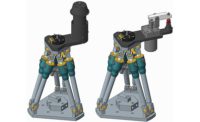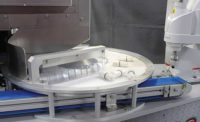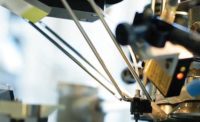An epiphany is often defined as the moment when someone more clearly understands a problem or situation, or sees it from a different perspective. In the context of assembly, the term might refer to when an inventor or engineer has the idea for a new or better product or process.
However, the word can also refer to when an individual realizes that a product has potential beyond its current use. Managers at Graco Inc. had this insight concerning its in-house flexible feeder a little more than one year ago.
“On several occasions from 2009 to 2012, component and robotic suppliers inquired into where they could buy our internally developed flexible parts feeder,” recalls Jon Knutson, business development director for Graco Inc. “We developed this feeder when we automated various production lines. It enabled us to lower costs and improve quality as we implemented high-mix, low-volume manufacturing.”
Knutson says the company preferred making its own feeder to purchasing any available flexible feeders because they were not durable enough to withstand real world manufacturing conditions. Also, traditional vibratory bowl feeders were not an option because they lacked the flexibility to handle parts ranging from metal gears and bearings, to plastic handles, switches and seals.
Continual interest in the original feeder convinced Graco to research the feeder’s potential in the assembly market. Knutson and others began talking with robotic integrators, trade-show attendees and many potential end-users.
By early 2013, Graco formed a new-product engineering team to transform its original feeder design into a commercially viable product. Over several months, the feeder’s table and its surface geometry were redesigned and optimized. Advanced vibration dampening features were added, and operator controls were incorporated in the unit base.
In October 2013, the G-Flex 1500 feeder was brought to market. It was showcased at the inaugural ASSEMBLY Show later that month.
The G-Flex is assembled and tested in a dedicated area within Graco’s 330,000-square-foot manufacturing facility in Rogers, MN. There—as well as at plants in Minneapolis and Sioux Falls, SD—dozens of the G-Flex feeders are at work every day feeding parts for components and subassemblies used in airless spray guns and paint sprayers, and line-striping equipment. The company also still operates many of the original feeders on the assembly lines.
Many Parts, Many Models
The purpose of any flexible feeder is to present parts to a vision-guided robot. One or more cameras take images of the parts, and vision software indicates which parts the robot needs to retrieve and move.
The G-Flex presents parts on a 15-by-24-inch table covered by a thin green carpet in six sections. Several 20-degree-angle areas on the carpet ensure proper orientation.
Once presented, the batch of parts is briefly vibrated. As weight on the table is increased or decreased, the controller automatically adjusts vibration frequency.
The table is uniquely designed to recirculate non-selectable parts and bring them back to the camera’s field of view. Table vibration amplitude and frequency are adjustable. Chamfered corners prevent part accumulation.
According to Knutson, the feeder’s flexibility extends beyond being able to handle multiple types of parts and parts made of various materials. It can feed oily parts or those that might contain machining chips or bits of the cardboard box from which parts are dumped into the feeder’s hopper (0.9-cubic-foot capacity).
In addition, the G-Flex is an off-the-shelf feeder that is easy to set up. End-users simply connect 120V power to a junction box and then to a PLC (via an M12 connection). Optional accessories include a camera mounting plate and stand assembly, a stacked-part eliminator, a part separator and a feed optimizer.
Flexomation LLC offers several series of flexible feeders. The company’s latest model is the MicroG, which is specifically designed to handle parts as small as 0.001 inch in diameter and 0.007 inch in length.
Eric Lewis, founder and owner of Flexomation LLC, says the feeder features a glass surface that moves parts forward and backward. It is tempered to ensure cleanliness and durability. The unit is controlled using standard input-output signals. An operator presses a keypad to initiate flipping action and properly orient the parts.
“Manufacturers can use this feeder with a camera that is either top mounted, pointing downward, or bottom mounted, pointing upward,” notes Lewis. “With an upward pointing camera, the feeder’s design allows for uninterrupted parts processing because the robot never blocks the camera’s field of vision.”
Both the FX 180 and FX 240 models in the company’s Anyfeed series can handle a wide range of parts, including cylindrical ones. The feeders are available with a flat or grooved feed surfaces. Throughput varies with part type and ranges from 30 to 60 parts per minute. The FX180 handles parts up to 1 inch square, the FX240 up to 2 inches square.
“The controller lets users program how much force is needed to flip the parts, depending on material,” explains Lewis. “Lead parts need a lot more force than plastic or aluminum parts.”
The company also offers the FF250 series. Model ES (embedded servo) handles complex and soft parts, such as those made of silicon and rubber. Model MB features a MotionBlox-10 control platform that allows seamless interfacing with CX-controller-based robots from Adept Technology Inc.
Adept’s FlexiBowl and AnyFeeder also work well with the company’s CX-based SCARA, delta and six-axis robots. Featuring a circular design, the FlexiBowl offers high productivity for small parts of different shapes and materials, says Mark Noschang, applications engineering manager for AdeptTechnology Inc. It also separates parts that are fragile, cylindrical or oiled.
Parts are placed on the feeder’s circular conveyor from a separate hopper. A direct-drive motor quietly rotates the conveyor forward and backward until each batch of parts is retrieved. As-needed part flipping is initiated by a pneumatic cylinder located under the conveyor. Throughput can exceed 60 parts per minute.
Two models are available. The conveyor on the Model 350 is 325 millimeters in diameter. The conveyor on the Model 500 is 500 millimeters in diameter. Both come with several serial interface connections.
The horizontal AnyFeeder is designed to handle bulk parts. It features a 22-pound-capacity hopper that measures 238 by 652 millimeters, and a stationary feed surface that provides a 240-by-320 millimeter field of view. Part flipping is initiated by a pneumatic cylinder.
To quicken product changeover, the hopper can be automatically purged. Parts are emptied out of the hopper from the rear and collected in a bin provided by the manufacturer. The stainless steel feeder also features a brushless servo drive; single electrical, pneumatic and serial connections; and eight input and 12 output channels. A textured feed surface is optional.
Flexible feeders don’t necessarily have to be standard products like the G-Flex or Anyfeed. Depending on the parts, feeder bowl manufacturers can design machines with some degree of flexibility.
“We don’t have a standard line of flexible feeders,” states Greg Pflum, president of Performance Feeders Inc. “Our approach is to create a custom system for each job.”
He recalls a feeder the company made a couple years ago for a private munitions manufacturer. The feeder brought several types of bullets to a machine that sealed them.
“Manufacturers not only want their flexible feeders to handle more types of parts,” explains Pflum. “They also continue to demand higher throughput. About 35 years ago, 15 to 20 parts per minute was expected. Today, the average feed rate is 45 to 50 parts per minute, but I have seen applications with rates of more than 200 parts per minute.”
Selection Factors
The decision to use a flexible feeder rather than a bowl feeder should not be made in haste. Several factors need to be considered.
Lewis says manufacturers must never forget that every bowl feeder is designed to only handle one type of part with specific dimensions. As a result, the feeder might not function properly when a manufacturer even slightly changes just one part dimension.
Part type and geometry also affect feeder performance. Knutson says flexible feeders are better at separating complex parts, like a drive assembly, and lightweight and plastic parts than bowl feeders.
Flexible feeders also handle out-of-tolerance parts better, according to Pflum. This is important because manufacturers rarely receive a box of parts that is 100 percent within tolerance.
“When flexible feeding first hit the market in the 1990s, cameras were in the $10,000 range, and a pick-and-place robot cost around $25,000,” says Pflum. “Advances in these technologies have lowered the cost of a camera to about $2,500 and cut robot costs in half, making flexible feeding more economical.”
Pflum says flexible feeders also offer companies the potential to grow by expanding their part offerings. However, this potential must be weighed against the flex feeder’s higher price tag. If the potential for part expansion is minimal, it may be more cost-effective to purchase a bowl feeder.
Part cleanliness and machine noise are common concerns that need to be addressed. Bowls vibrate and often produce particulate matter that can abrade parts and lessen feeder productivity. In contrast, dust and lubricants rarely hurt the performance of a flexible feeder.
As for noise, flexible feeders tend to be quieter than bowl feeders. Lewis says the company’s FX model has a noise level near 70 decibels when handling nonmetal parts, and below 80 decibels when handling metal parts. A bowl feeder in the same application is quite a bit louder.
Manufacturers that need to feed many types of parts should find out how quickly a feeder’s feed surface can be changed to optimize part orientation, recommends Noschang. If the changeover for a bowl feeder is too time-consuming, its production advantages over a flexible feeder may be lost. Ball bearings, for example, orient best on a waffle-type surface; circular parts, on a rubber-coated surface.
“Manufacturers can quickly assess whether or not a flexible feeder meets their needs,” notes Lewis. “No tooling changes or setup time is required. Just walk over to the machine and drop in the parts.”
Bowling for Flexibility
Companies that prefer the higher productivity of bowl feeders can take steps to increase their flexibility. One option is retooling, although doing so is neither easy nor inexpensive because most of the bowl is welded. Not surprisingly, many old bowls are scrapped for metal rather than retooled.
Manufacturers can also replace the bowl but keep the base, or have multiple bowls supply parts to the same takeaway point. In the latter setup, one bowl can be used for each part variation.
Another option is to add a vision system. Noschang says that, depending on product geometry and part mix, it may be more cost-effective to modify a feeder bowl and add a vision system than to purchase a flexible feeder.
Companies might also want to replace their old bowl feeders with bowl-shaped centrifugal feeders. A rotating plastic disk at the bowl bottom forces parts against tooling that accepts correctly oriented parts and rejects misoriented ones. To feed a new part, assemblers just need to change the outside tooling ring.
Manufacturers considering bowl feeders are well-advised to discuss their current needs andfuture plans with their supplier, Pflum says. This information enables the supplier to make a feeder that allows for quick and easy interchangeability of multiple bowls.








